This article was posted by CrystalWind.ca.
Hathor - The Great One of Many Names
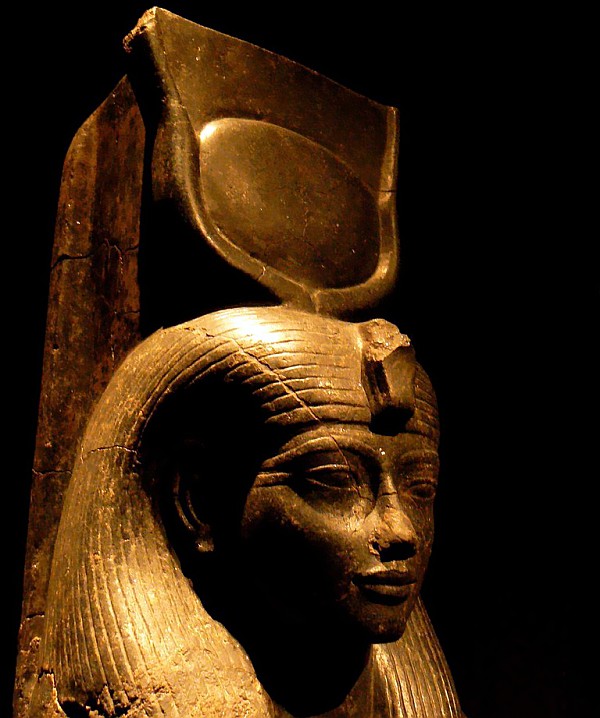
Hathor is one of the most ancient Egyptian goddesses. She was known as "the Great One of Many Names" and her titles and attributes are so numerous that she was important in every area of the life and death of the ancient Egyptians. It is thought that her worship was widespread even in the Predynastic period because she appears on the Narmer palette. However, some scholars suggest that the cow-headed goddess depicted on the palette is in fact Bat (an ancient cow goddess who was largely absorbed by Hathor) or even Narmer himself. However, she was certainly popular by the Old Kingdom as she appears with Bast in the valley temple of Khafre at Giza. Hathor represents Upper Egypt and Bast represents Lower Egypt.
She was originally a personification of the Milky Way, which was considered to be the milk that flowed from the udders of a heavenly cow (linking her with Nut, Bat and Mehet-Weret). As time passed she absorbed the attributes of many other goddesses but also became more closely associated with Isis, who to some degree usurped her position as the most popular and powerful goddess. Yet she remained popular throughout Egyptian history. More festivals were dedicated to her and more children were named after her than any other god or goddess. Her worship was not confined to Egypt and Nubia. She was worshipped throughout Semitic West Asia, Ethiopian, Somlia and Libya, but was particularly venerated in the city of Byblos.
She was a sky goddess, known as "Lady of Stars" and "Sovereign of Stars" and linked to Sirius (and so the goddesses Sopdet and Isis). Her birthday was celebrated on the day that Sirius first rose in the sky (heralding the coming innundation). By the Ptolemaic period, she was known as the goddess of Hethara, the third month of the Egyptian calendar.
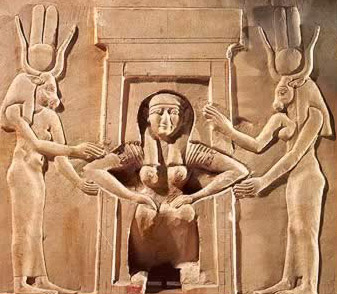
As "the Mistress of Heaven" she was associated with Nut, Mut and the Queen. While as "the Celestial Nurse" she nursed the Pharaoh in the guise of a cow or as a sycamore fig (because it exudes a white milky substance). As "the Mother of Mothers" she was the goddess of women, fertility, children and childbirth. She had power over anything having to do with women from problems with conception or childbirth, to health and beauty and matters of the heart. However, she was not exclusively worshipped by women and unlike the other gods and goddesses she had both male and female priests.
Hathor was also the goddess of beauty and patron of the cosmetic arts. Her traditional votive offering was two mirrors and she was often depicted on mirrors and cosmetic palettes. Yet she was not considered to be vain or shallow, rather she was assured of her own beauty and goodness and loved beautiful and good things. She was known as "the mistress of life" and was seen as the embodiment of joy, love, romance, perfume, dance, music and alcohol. Hathor was especially connected with the fragrance of myrrh incense, which was considered to be very precious and to embody all of the finer qualities of the female sex. Hathor was associated with turquoise, malachite, gold and copper. As "the Mistress of Turquoise" and the "lady of Malachite" she was the patron of miners and the goddess of the Sinai Peninsula (the location of the famous mines). The Egyptians used eye makeup made from ground malachite which had a protective function (in fighting eye infections) which was attributed to Hathor.
She was the patron of dancers and was associated with percussive music, particularly the sistrum (which was also a fertility fetish). She was also associated with the Menit necklace (which may also have been a percussion instrument) and was often known as "the Great Menit". Many of her priests were artisans, musicians, and dancers who added to the quality of life of the Egyptians and worshipped her by expressing their artistic natures. Hathor was the incarnation of dance and sexuality and was given the epithet "Hand of God" (referring to the act of masturbation) and "Lady of the Vulva". One myth tells that Ra had become so despondent that he refused to speak to anyone. Hathor (who never suffered depression or doubt) danced before him exposing her private parts, which caused him to laugh out loud and return to good spirits.
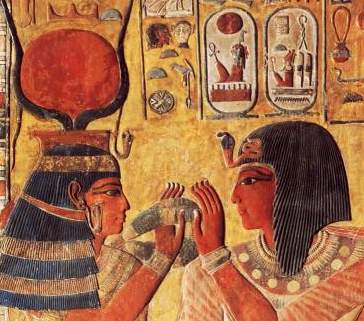
As the "lady of the west" and the "lady of the southern sycamore" she protected and assisted the dead on their final journey. Trees were not commonplace in ancient Egypt, and their shade was welcomed by the living and the dead alike. She was sometimes depicted as handing out water to the deceased from a sycamore tree (a role formerly associated with Amentet who was often described as the daughter of Hathor) and according to myth, she (or Isis) used the milk from the Sycamore tree to restore sight to Horus who had been blinded by Set. Because of her role in helping the dead, she often appears on sarcophagi with Nut (the former on top of the lid, the later under the lid). She occasionally took the form of the "Seven Hathors" who were associated with fate and fortune telling. It was thought that the "Seven Hathors" knew the length of every childs life from the day it was born and questioned the dead souls as they travelled to the land of the dead. Her priests could read the fortune of a newborn child, and act as oracles to explain the dreams of the people. People would travel for miles to beseech the goddess for protection, assistance and inspiration. The "Seven Hathors" were worshiped in seven cities: Waset (Thebes), Iunu (On, Heliopolis), Aphroditopolis, Sinai, Momemphis, Herakleopolis, and Keset. They may have been linked to the constellations Pleiades.
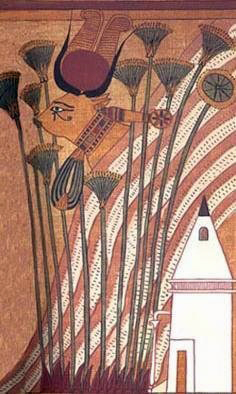
However, she was also a goddess of destruction in her role as the Eye of Ra - defender of the sun god. According to legend, people started to criticize Ra when he ruled as Pharaoh. Ra decided to send his "eye" against them (in the form of Sekhmet). She began to slaughter people by the hundred. When Ra relented and asked her to stop she refused as she was in a blood lust. The only way to stop the slaughter was to colour beer red (to resemble blood) and pour the mixture over the killing fields. When she drank the beer, she became drunk and drowsy, and slept for three days. When she awoke with a hangover she had no taste for human flesh and mankind was saved. Ra renamed her Hathor and she became a goddess of love and happiness. As a result, soldiers also prayed to Hathor/Sekhmet to give them her strength and focus in battle.
Her husband Horus the elder was associated with the pharaoh, so Hathor was associated with the Queen. Her name is translated as "The House of Horus", which refers both to the sky (where Horus lived as a Hawk) and to the royal family. She had a son named Ihy (who was a god of music and dancing) with Horus-Behdety and the three were worshipped at Denderah (Iunet). However, her family relationships became increasingly confusing as time passed. She was probably first considered to be the wife of Horus the elder and the daughter of Ra, but when Ra and Horus were linked as the composite deity Re-Horakty she became both the wife and the daughter of Ra.
This strengthened her association with Isis, who was the mother of Horus the child by Osiris. In Hermopolis (Khmunu) Thoth was the foremost god, and Hathor was considered to be his wife and the mother of Re-Horakhty (a composite deity which merged Ra with Hor-akhty).
Of course, Thoth already had a wife, Seshat (the goddess of reading, writing, architecture and arithmetic), so Hathor absorbed her role including acting as a witness at the judgement of the dead. Her role in welcoming the dead gained her a further husband - Nehebkau (the guardian of the entrance of the underworld). Then when Ra and Amun merged, Hathor became seen as the wife of Sobek who was considered to be an aspect of Amen-Ra. Yet Sobek was also associated with Seth, the enemy of Horus!
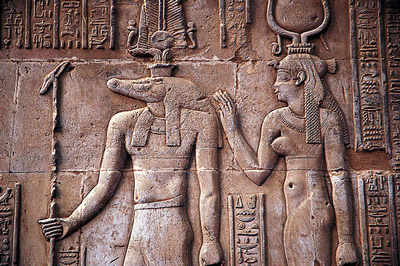
She took the form of a woman, goose, cat, lion, malachite, sycamore fig, to name but a few. However, Hathor's most famous manifestation is as a cow and even when she appears as a woman she has either the ears of a cow, or a pair of elegant horns. When she is depicted as entirely a cow, she always has beautifully painted eyes. She was often depicted in red (the color of passion) though her sacred color is turquoise. It is also interesting to note that only she and the dwarf god Bes (who also had a role in childbirth) were ever depicted in portrait (rather than in profile). Isis borrowed many of her functions and adapted her iconography to the extent that it is often difficult to be sure which of the two goddesses is depicted. However, the two deities were not the same. Isis was in many ways a more complex deity who suffered the death of her husband and had to fight to protect her infant son, so she understood the trials and tribulations of the people and could relate to them. Hathor, on the other hand, was the embodiment of power and success and did not experience doubts. While Isis was merciful, Hathor was single minded in pursuit of her goals. When she took the form of Sekhmet, she did not take pity on the people and even refused to stop killing when ordered to do so.
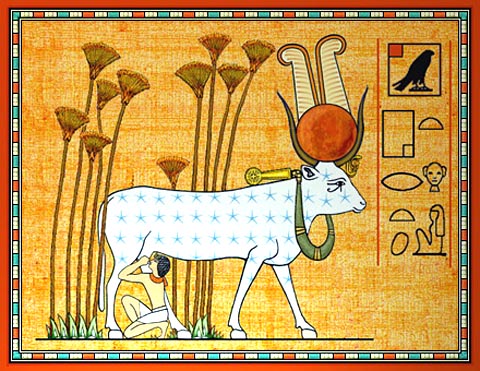
Iconographies of The Goddess Hathor
The goddess Hathor has several iconographies: a woman crowned with stylized horns surrounding a solar disc, a woman with the head of a cow, or simply a cow. Of course, the choice of the representation depends on the function of the goddess, the artist wanted to emphasize: the nurturing Hathor will be depicted as a cow; Hathor assimilated to Isis as protector of the dead will be depicted as a woman. Among the many personalities of this goddess, there is Hathor with the little of "Mistress of the Theban necropolis," and as such, she is often represented as a cow. Sometimes she appears coming out of a high mountain symbolizing the Libyan cliff where the tombs are dug and where the "Castles of Millions of Years" are located. In Deir el-Bahri, in her funerary temple, Hatshepsut reserved a special space for her. Sometimes she manifests herself as protector of the necropolis; sometimes she adopts the qualities of a cow nursing the future queen.
Daughter of Re: considered to be the eye of the sun, Wife of Horus (sometimes mother of Horus)
Goddess with several functions: celestial deity. lady of Far lands. Goddess of joy. Mistress of the Theban necropolis. lady of the sycamore ...
Principal place of worship: Dendara (Upper Egypt)
Representation: a woman with two horns surrounding the solar disc. a cow or a woman with a cow's head
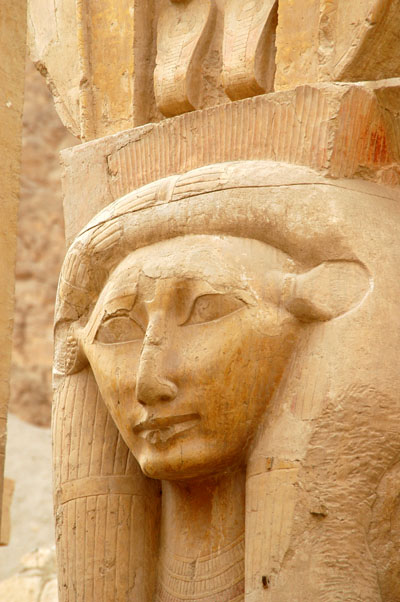
Hathor's origins go back to the earliest times in Egypt's history, as her name appears in the oldest historical document known to this day, the "Palette of Narmer," a votive palette made out of schist, that recalls the unification of the two kingdoms of Egypt by Narmer, first pharaoh of the first dynasty. For the country, this event marks the passage from prehistoric times to history and inaugurates the pharaonic era. On the top part of the palette, both sides are adorned with heads of cows that symbolize the goddess Hathor. What is the justification of her presence on this document? The palette was found in Hierakonpolis, the antique city of Nekhen, of which the patron god was Horus. He appears here under a particular form: "Horus the Younger," son of Hathor, which makes the predominant location for his mother on the palette more understandable. Later, in the 6th Dynasty, Pepy I calls himself "son of Hathor," which seems reasonable since the king is considered to be the representative of Horus on earth. If Hathor is the mother of Horus, the king becomes son of Hathor.
In hieroglyphic writing, the name Hathor is read "Hut Hor," "the home of Horus" or the "cosmic dwelling of Horus" according to Plutarch. Hathor symbolizes the celestial space in which the solar Horus moves. As centuries go by, her cosmic functions are so expanded that she quickly becomes a universal goddess, a role she shares with Isis. In fact, from the New Kingdom on, the two goddesses finally merge and adopt each other's iconography; in many cases, only the texts and legends can tell them apart. Very often, such a deity is displayed on the walls of tombs and temples: a woman wearing a crown with two horns stylized into a lyre, ~ enc1o,sing the solar disc. Is it Hathor or Isis?
The answer to the question can only be given by reading the name of the deity, generally inscribed over her head. Sometimes the context gives an idea on the real identity of the goddess. For instance, if she appears with Osiris and Horus, it is certainly Isis. On the contrary, if she is depicted in a scene where she nurses the king, it can only be Hathor in her role as a nurturing deity.
The list of her attributions is very impressive: she is the goddess of love, lady of music, lady of Byblos and Punt, mistress of far lands, lady of the turquoise, lady of inebriation, mistress of ballets and gay songs ... She nurses the royal child: in this case she is depicted as a woman or a cow feeding the young heir. She protects the necropolis of Thebes: she appears as a cow coming out of a high mountain symbolizing the Libyan cliff where the tombs are dug. She appears as goddess of dance, music and joy: she then has the aspect of a young woman waving a sistrum, which is a musical instrument that looks like a rattle, the sound of which is said to excite the gods. She is also lady of the sycamore in Memphis: in this case, she rises from a sycamore, which is a tree that feeds the souls of the deceased in the netherworld.
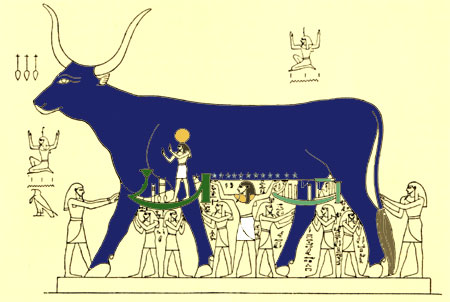
From an iconographical point of view, her most interesting appearance is the one where she is depicted as sovereign of the four comers of the sky and mistress of the cardinal points: she is represented on specific pillars, since they are crowned with "hathoric" capitals, with a cow's head engraved on each side. Each of these four faces symbolizes a facet of her personality: Hathor the lioness as the eye of Re' slaying the enemies of the sun, Hathor the cow as goddess of love and rebirth, Hathor the cat as protector of homes and royal nurse, Hathor the cobra as the incarnation of beauty and youth.
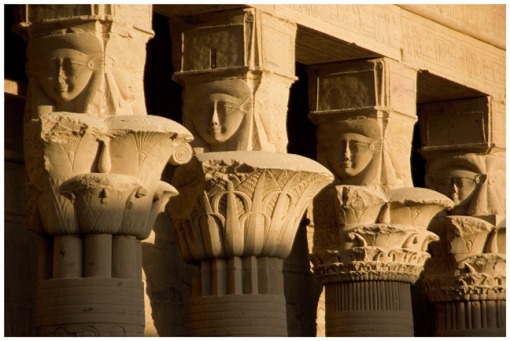
Her main sanctuary is in Dendara, in Upper Egypt. The presently visible temple is the work of the last of the Ptolemies and several pharaohs of the Roman period, but if one is to believe the texts, this holy place goes back to the earliest times: it is very probable that the plan of the building was inspired from documents of the Old Kingdom, especially the reigns of Khufu and Pepy I. Every year, a celebration enlivened his part of Egypt: Hathor left her sanctuary in Dendara to visit her husband Horus Behedety, a form of Horus worshipped in Edfu. This town is about ninety miles up the Nile.
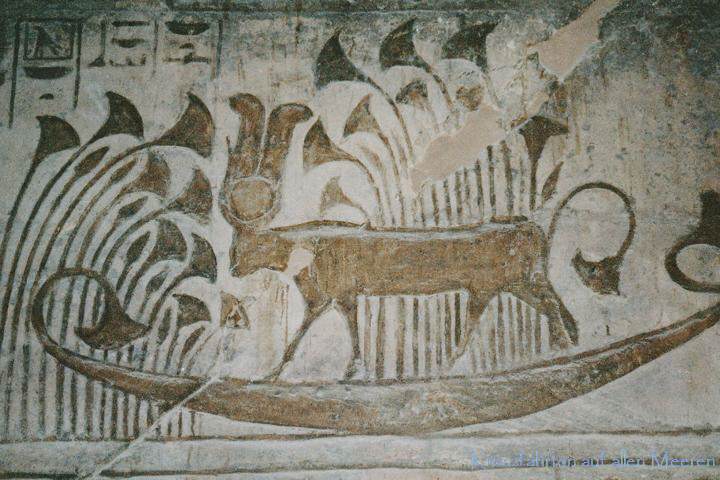
For this trip, Hathor leaves her home for three weeks: the "Mistress of Dandera is brought up the river, so that she can have a joyous reunion with Horus. " For this long trip, the solemn procession travels by river; the statue of Hathor is placed on a majestic boat, "the Beautiful in Love," that sails up the Nile for four days. For its part, the clergy of Edfu makes preparations for the meeting of the spouses that is to happen outside the shrine, in a little chapel north of the town, at a very precise moment: the eighth hour of the day of the new moon of the eleventh month of the year. There Horus stands ready for his wife. As soon as she arrives, the festivities start, and the people living all around join in. She is acclaimed, she is greeted, her qualities are praised, music is played for her; she is Hathor "the Golden," "the Lady of Goddesses," "the Mistress," "the Lady of inebriation, music and dance. " Then everyone gets into his own boat, and the procession makes for the main shrine. Once there, the priests pull the boats out of the water and bring them within the walls of the temple. Hathor makes the most of the occasion to see her father again, the sun, who manifests himself in Edfu by the side of Horus Behedety.
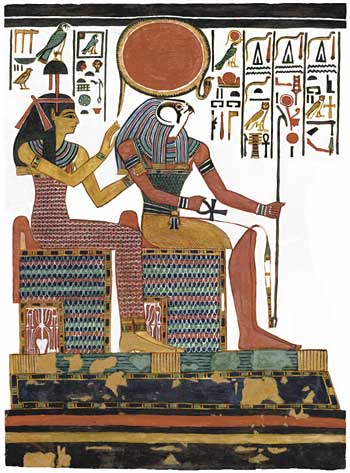
The ancient texts present Hathor as the uraeus, one of the manifestations of the solar eye, and explain how here "she meets her father Ne', who exults to see her, for it is his eye that is back. " The mythical wedding can at last take place; it is accompanied by great rejoicing, at the end of which the two spouses are left alone together for their wedding night. The festivities in Edfu really start the next day, and they last the fourteen days of the crescent moon. Fourteen days during which rites, sacrifices, commemorations, visits to the shrine take place ... The priests specifically organize a set of ceremonies for the divine souls and "the gods that died in Edfu. " These are the primeval gods, created by the demiurge to assist him in his creation, but called to disappear after the creation. It is said that "their souls flew to heaven, where they live amongst the stars," and that "the necropolis of Edfu contains the bodies of those ancestral gods. " Every year, "Re' goes there, accompanied by the Majesty of his uraeus (Hathor); he takes care of his children, the divine and respectable bodies who rest forever in Edfu, leaves them offerings and listens to their prayers." The festivities end with a great banquet at the end of which each goes back to his own sanctuary: Hathor to Dendara and Horus to Edfu.
© CrystalWind.ca 2024. All content (articles, imagery, fair use) & design protected. Written permission required for copying. All rights reserved.
Join the Conversation Now! Comment Below! ![]()

Spirit Animal Totem Of The Day!
Crystal Of The Day!
Latest Articles
The Crystal Wind Oracle
Myth & Magic Card Deck!
Details Here!
NEW Expanded
Printed & Boxed!
Now with 58 cards!
CrystalWind.ca is free to use because of
donations from people like you.
Donate Now »

Unlock Your Light: Join Lightworkers Worldwide on CrystalWind.ca!
Articles: Hindu Mythology
Articles: Egyptian Mythology
Articles: Compendium
Follow Us!
Who is Online Now
We have 21290 guests and no members online
Featured This Month
Taurus Mythology
The Taurus Myth The Taurus myth is most often interpreted as the story of Z... Read more
The Crystal Wind Oracle Card Deck
The Crystal Wind Oracle™ The Crystal Wind Oracle Myth & Magic Card D... Read more
The Seven Chakras and their Meanings
If you could imagine chakras as circles of energy, flowing all the way throu... Read more
Sun in Taurus
Sun in Taurus April 21 through May 21 An Overview of Sun Sign Characteristi... Read more
Bright Beltane Blessings!
The wheel turns to Beltane, also known as Mayday, marking the beginning of S... Read more
Cartomancy - Fortune Telling Using Playing C…
Cartomancy is the act of divining using cards. Divining means to find out by... Read more
Frogs Return Moon
Beaver – Chrysocolla - Blue Camas – Blue April 20 – May 20 The Frogs Retur... Read more
The Time of No Time: Beltane!
Around the medicine wheel of life we go, from season to season (solstice to ... Read more










































